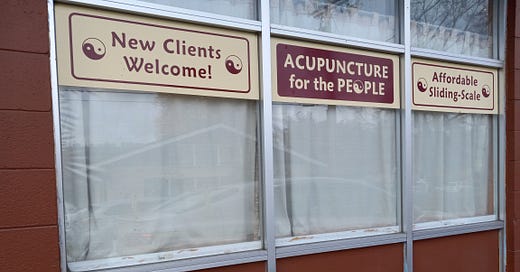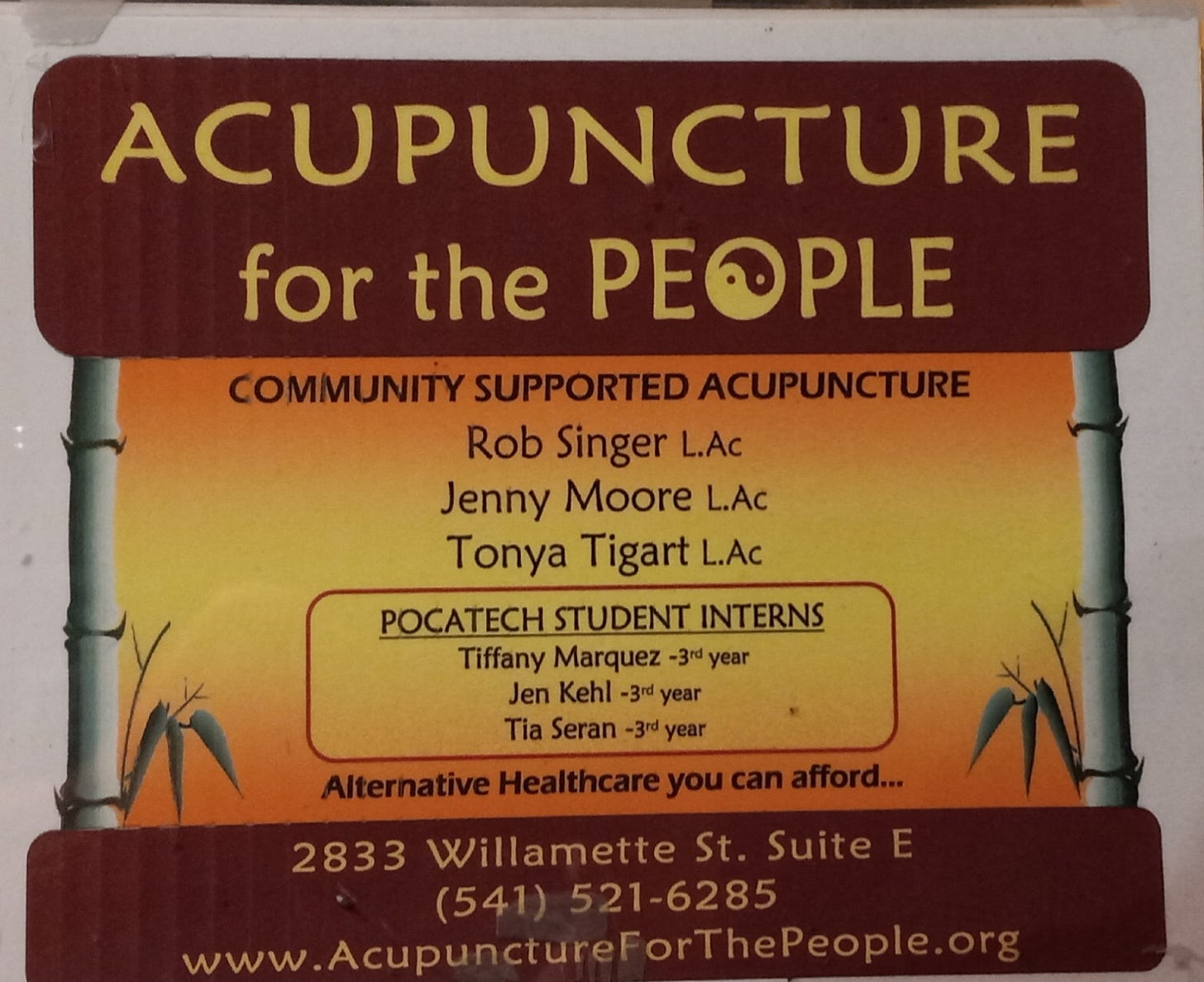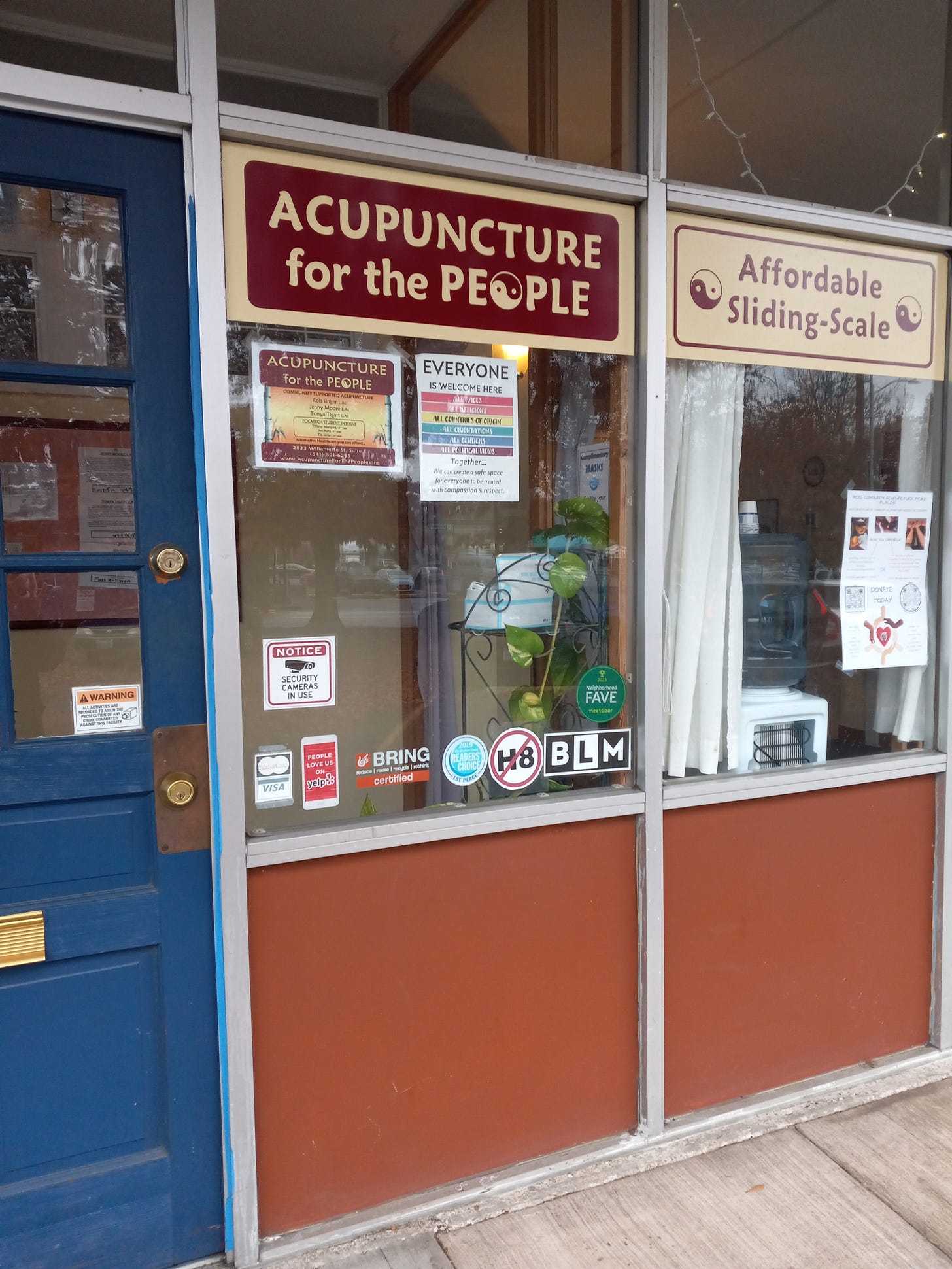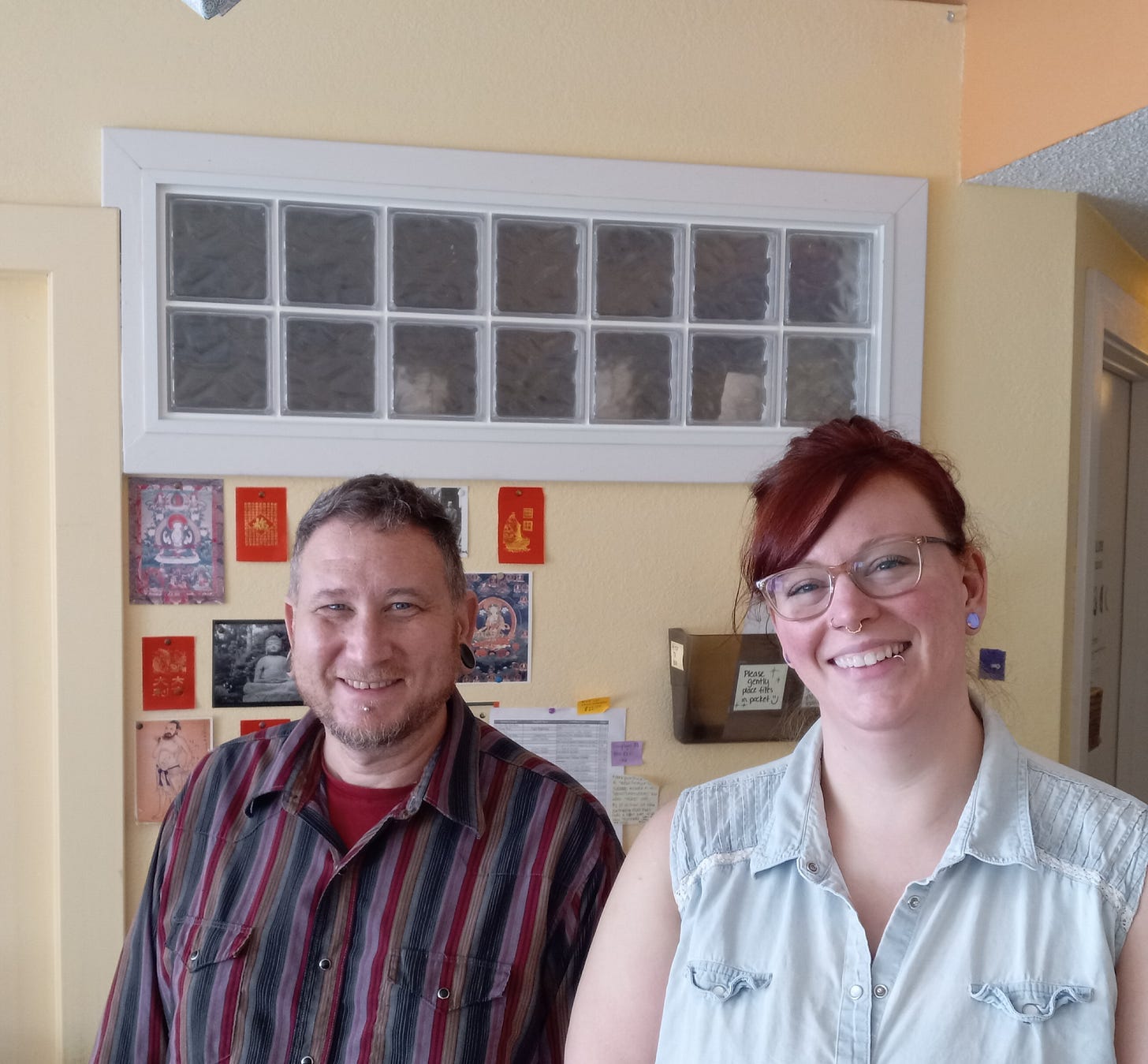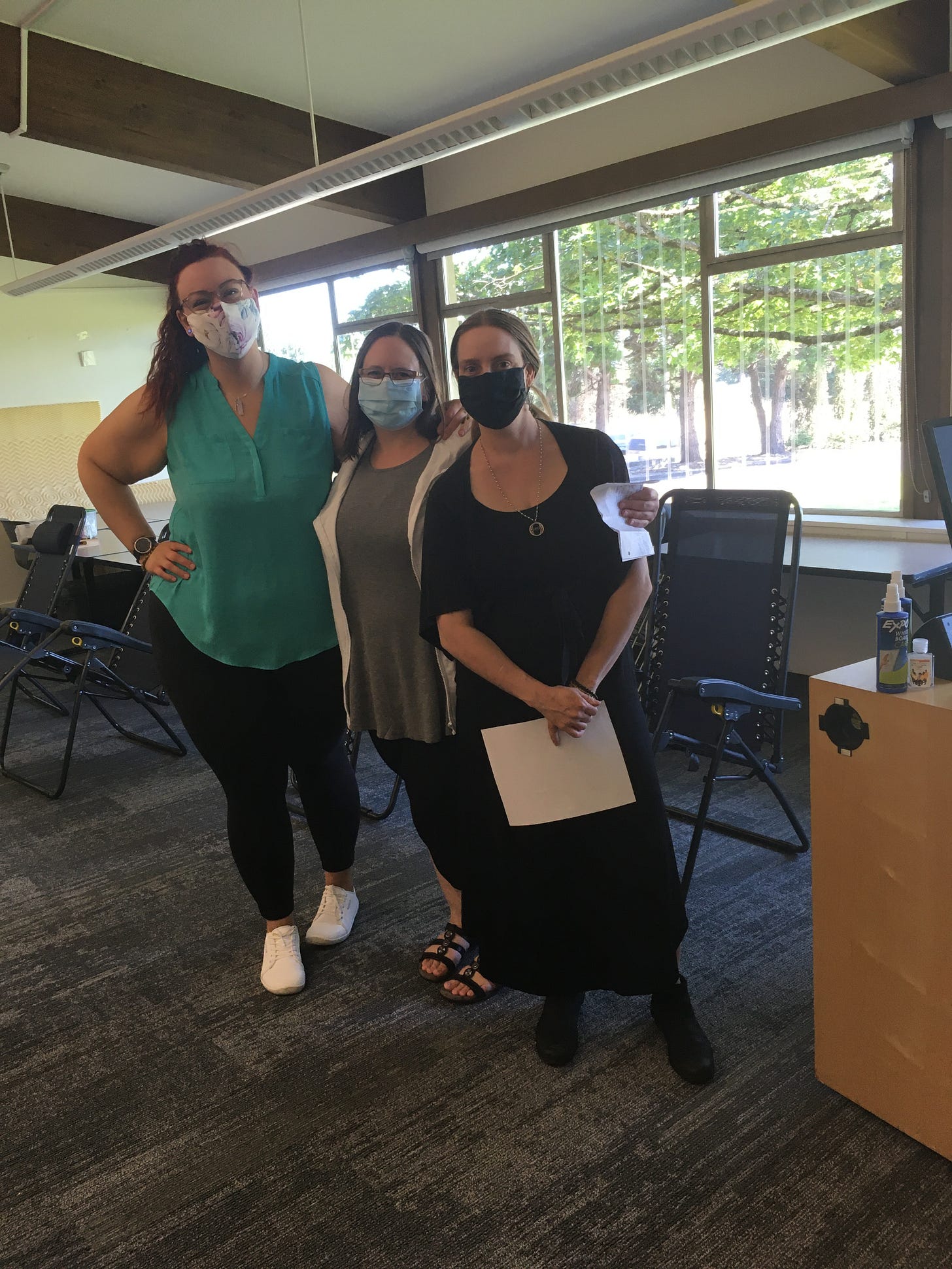WCA and POCA Tech are working on creating more strategic partnerships with other organizations. A special category of those partnerships is community acupuncture clinics that help us fulfill our goal of turning out well-trained acupunks who can hit the ground running in their own communities once they graduate. POCA Tech has four “Away Clinics” outside of Portland: Wasatch Community Acupuncture in Salt Lake City, UT; Ashland Community Acupuncture in Ashland, MA; Quad Cities Community Acupuncture in Moline, IL; and Acupuncture for the People in Eugene, OR. Big thanks to third year student Jennifer Kehl for sharing the story of how one of those partnerships came into being! (Spoiler alert: student organizing.)
It was a dark and stormy winter morning. My stomach had that hollow, nauseous feeling that comes from waking at 4:30 AM. Eyes gritty, pillow creases on cheeks, my two classmates and I worked our way down 125 miles of lonely highway from Eugene to Portland on our weekly commute to our intern shifts at our beloved WCA-Rockwood clinic.
White-knuckling it through fog and rain, we kept each other engaged with one of two topics:
1: Terribly-inappropriate-never-to-be-repeated stories and musings that were eerily even more hilarious at 5:30 in the morning.
2: Does an alternate universe exist where we don’t have to white-knuckle it every Wednesday from Eugene to Portland? Where we could do our internship without a 2+ hour commute?
Although we are superfans of WCA and loved our shifts and supervisors at Rockwood, we couldn’t help but imagine how nice it would be to start treating our own community. We have all been patients of Acupuncture for the People for years. I even work there as a receptionist, and Tiffany is the office manager. It’s where we fell in love with community acupuncture. We are invested.
Acupuncture for the People opened in 2006. Rob Singer, the owner, told me he learned about community acupuncture from a journal article Lisa Rohleder had written. He opened the clinic soon after based on Lisa’s model. With just eight chairs and three acupuncturists, it’s truly amazing how many people cycle through every week, and these people are loyal. Patients stop at the reception desk every day to say how important the clinic is to them, and how much it’s helped them. I feel the same.
So we started hatching a plan. (We had plenty of time, see: 125 miles to Rockwood.) Could we somehow make internships happen at Acupuncture for the People? The task seemed insurmountable. Then we started breaking it down into pieces.
First, we needed to bring the idea to Rob and the other punks. They would be our supervisors after all, and there was a lot to consider. How would student interns impact the schedule? How do the punks feel about adding a shift to their busy weeks? How receptive would the patient community be to a student clinic? And a big one: how would training students financially impact the clinic?
Don’t get me wrong. We knew what we were asking, and we knew it was A LOT. We wanted something to exist that had never existed. We knew we would need to build it.
Luckily, we were trapped in a car together for 4+ hours every Wednesday, and luckily one of us was the office manager. Tiffany helped Tia and I understand the inner workings and financials of the clinic, and over the next few months, she inspired Rob and the other punks with visions of what a student clinic might look like.
After consulting students who helped set up Away Clinics in their areas, we drafted a proposal. It included additions/changes to the current patient schedule that might work, and a basic cost/benefit analysis based on ideas we had for the student clinic sliding scale.
We brainstormed ways the student clinic might actually benefit Acupuncture for the People. With a lower sliding scale, patients on a tight budget might be able to come in more often. The student clinic would offer an expanded schedule. This is a busy clinic that frequently has patients on the waiting list.
The three of us have been part of this community for a long time, and we would most likely bring in people from our own circles as well. Interning at the clinic would be like “on the job training” for me and Tiffany, who plan on practicing there after graduation.
We pointed out that this could be the perfect time to try a student clinic. We would be in our last year of our internship and we no longer need intensive, hands-on supervision. We’re already familiar with how POCA Tech runs the student clinic and we could offer help with the logistics. Oh yeah, and the office manager is one of the students. The time was ripe!
Into the proposal all this went.
We waited for the idea to settle.
When we found out Rob and the other punks were on board for this adventure, it felt like we’d won the lottery.
With the help of POCA Tech’s dean and admin, we dove head first into the necessary bureaucracy. Luckily, a previous student had already broken ground with the school’s regulatory bodies. As long as we did the paperwork, and met all the requirements, POCA Tech could designate Acupuncture for the People as an Away Clinic.
Ahhh…but the paperwork! Stuff of nightmares.
Like I said, we knew what we were asking, and we knew the heavy lifting for the bureaucracy was ours. In fact, we insisted on it. It was helpful that one of our classmates shared the paperwork completed from her Away Clinic. This provided us with a template.
Tiffany worked on the application itself. POCA Tech has strict requirements about Away Clinics being actual community acupuncture clinics. That was easy to prove. Included in there were other requirements like: financials for the clinic, supervisor licensure requirements, medical records standards, and state and federal safety regulations. She also made sure the clinic was ADA accessible.
Tia and I worked on making the OSHA manual as legit as it needed to be, and made sure all safety regulations were in place (definitely the cause of at least one migraine–but totally worth it).
Meanwhile, Rob figured the numbers for what might work for the sliding scale. He also worked on introducing us and the student clinic to the public. We submitted short bios and pictures which he posted in the lobby and on the website. He included details of how the clinic will work in the monthly newsletter.
Tiffany oriented the reception staff to the student clinic logistics, among a hundred other things. She had the most heavy lifting, and Tia and I are forever in her debt.
During this process, we learned a lot about working together. We each took our part in the process and supported each other when needed. Sometimes one of us would get discouraged, but the other two were there to hold the line.
In Master Tung acupuncture (one of the clinical approaches we learn), there are frequently groups of three needles used together. They are called a “dao ma”. It’s thought that the three needles together have more of an effect then each one alone. I’m glad I was part of this “dao ma”.
What had seemed insurmountable in the beginning, on that dark wintery highway, turned out to be a project like most. Once we hatched the idea, broke it down into pieces, and prioritized things, it was just a matter of pushing up our sleeves and getting to work. Part of that work was maintaining hope.
Tia quoted Lisa recently in class: “Hope is a discipline”. Without that sustained effort of maintaining hope among ourselves, I don’t know if we could have made an Away Clinic happen.
I thank Tiffany for her optimism, Tia for her persistence, Skip and Jersey for helping us navigate the bureaucracy, and Rob, Tonya, and Jenny for giving us a chance.

